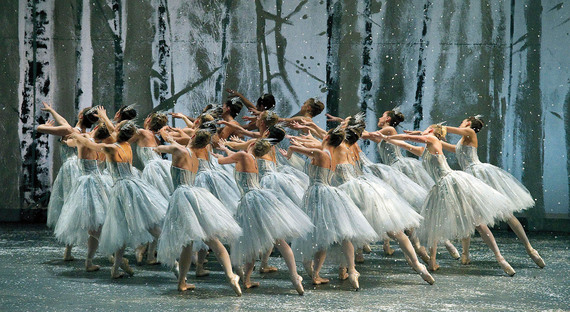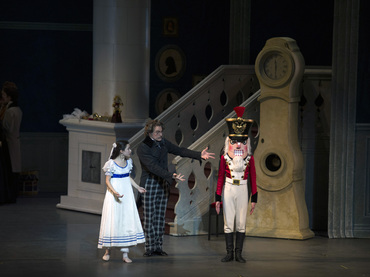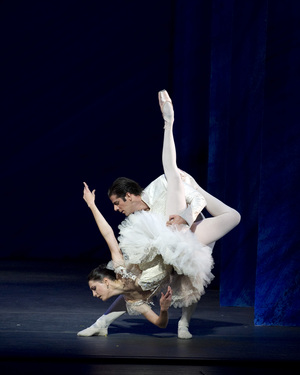Shortly after Thanksgiving, I came across a package of cocktail napkins printed with a funny quote: "Christmas is weird. What other time of year do you sit around a dead tree and eat candy out of your socks?"
This got me thinking about how bizarre many hallowed Christmas traditions are, perhaps none more so than The Nutcracker.
For many, myself included, Christmas would be incomplete without a live performance, favorite video or at least Tchaikovsky's magnificent score. But behind all the spectacle and sentimentality is a very strange story: a creepy uncle gives a girl a nutcracker, which magically comes to life and fends off an army of rodents before whisking the girl off to Candy Land -- only to leave her back at home, wondering just what those sugarplums were laced with.
Of course, each of these wacky story elements is suffused with symbolism, just like our beloved stockings and Christmas trees: beneath The Nutcracker's sugar coating is a coming-of-age story about overcoming fear and darkness to arrive at the light and sweetness of love.
That said, it's one thing to read this message in a program note, but quite another to see it played out on stage. Although many different versions of the ballet have delighted me, this has generally had to do more with style than substance.
Last Friday, however, I had the pleasure of seeing a Nutcracker that left me not merely entertained, but also touched. Now in its fourth season, American Ballet Theatre's version by Alexei Ratmansky has plenty of humor, but ultimately it succeeds by making the story more believable.
It starts in the kitchen of the Stahlbaum home, where cooks and maids feverishly finish preparations for the family Christmas party (we've all been there before). All the while, a little rascal of a mouse (the adorable Justin Soriau-Levine) gobbles food scraps while terrorizing the maids, foreshadowing the action to come.
At the party, we meet many characters we know from our own holiday family gatherings: a sneezing grandpa, a grandma who still has her groove, and boys behaving badly -- no matter what their age.
But it's the children who steal the scene, and they do it purely by being themselves. No marching soldiers here -- just a bunch of stomping tyrants and crybabies, dying to get their hands on their presents.
For young Clara, however -- danced with spunk and sparkle Friday night by Adelaide Clauss -- childhood is at the beginning of the end. Though this theme is central to virtually all Nutcrackers, the Ratmansky version interprets it with touching authenticity.
In the battle scene between the Nutcracker (Duncan McIlwaine) and the Seven-Headed Mouse King, it isn't only the Christmas tree that grows, but the entire living room. As Clara watches the battle from atop a giant chair, we get the sense that her small world is transforming into something much bigger, darker and scarier.
But after she defeats the Mouse King and weeps over her fallen Nutcracker, she also discovers her new world is also wondrous. Having reawakened as a boy, the Nutcracker opens his arms to the side and lifts his gaze and heart upward in a private gesture of gratitude, while Clara skims her hands over his arms with the wonder of early adolescent discovery.
This marks the beginning of one of the most beautiful Act 1 pas de deux I've seen, thanks to one of Ratmansky's most heartfelt nuances. As the young versions of Clara and the boy build the bond of friendship in that first, fateful encounter, their older selves (that night, Veronika Part and Marcelo Gomes) appear behind them, performing a parallel dance with a very different meaning. Although the adult gestures have clear romantic significance, most moving is the way the refined elegance of these principal dancers contrasts with the unaffected innocence of the children's movements -- perfect in their imperfections.
The joys and perils of discovery continue to unfold in the snow scene, which for me was the highlight of the performance. The snowflakes start as a delicate flurry in shimmering, silvery costumes and icicle tiaras. With neat, tucked jumps, shivering fingers and sparkling turns, they invoke snow's pristine beauty and seduce the children to play (which naturally involves a lot of pushing, shoving and other convenient excuses to touch each other).
But as the waltz progresses, their movements become larger and more menacing as the snow escalates to a full-blown blizzard. Just as things are looking hopeless for the frostbitten children, Drosselmeyer arrives in a sled to rescue them, but the message is clear to the budding youngsters: beware the dangers of seduction.
All this thematic and character development sets the stage for Act 2, but unfortunately, it doesn't go much further.
Part of this has to do with the second act's emphasis on divertissement, which, by its very nature, is meant purely to entertain. And entertain, it does: while Arabian features an exotic stud struggling to handle his four jealous wives, Russian is danced by a trio of bumbling buffoons. Bees pollinate pink blooms in Waltz of the Flowers, and it turns out Mother Ginger harbors not only polichinelles in her skirts.
Another part of it also has to do with the choreography. The divertissements are often whimsical to the point of absurdity, watering down the compelling, darker elements of the first act. But then the Sugar Plum pas de deux (for which Ms. Part and Mr. Gomes reappear) was so athletically challenging that it seemed the dancers forgot -- except for in contrived moments -- that they were supposed to be in love.
Finally, and most critically, there was very little chemistry between the adult prince and princess, a shortcoming that was made all the more regrettable by the wonderful dynamic between the children. Ms. Part, usually a lovely dancer, also seemed technically off that night, which might have affected her mood. When she popped her head out from the wings in the Sugar Plum Fairy variation (objectively, a very cute move), she seemed like she would have rather not come back on stage.
Still, as we are transported back to young Clara's bedroom on Christmas morning, we forgive these flaws as we remember the whole production as she does: as a beautiful dream -- a dream that fills us with both hope for the future, and nostalgia for the childhood she is leaving behind. And for once, it was a pleasure to not just read about these themes in the program, but to feel them in my heart.
American Ballet Theatre's Nutcracker runs through December 22 at BAM Howard Gilman Opera House in Brooklyn, NY. For tickets and more information, visit www.bam.org/nutcracker.



